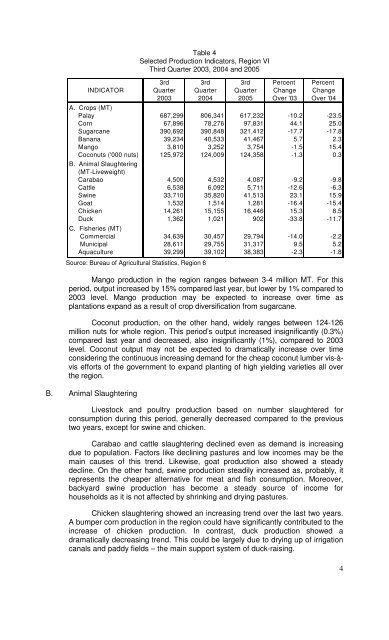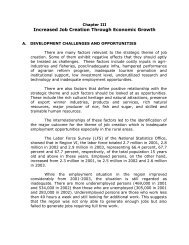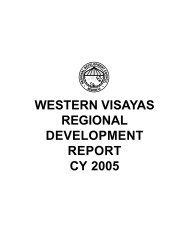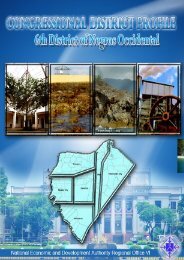REGIONAL ECONOMIC SITUATIONER Western ... - NEDA-RDC VI
REGIONAL ECONOMIC SITUATIONER Western ... - NEDA-RDC VI
REGIONAL ECONOMIC SITUATIONER Western ... - NEDA-RDC VI
You also want an ePaper? Increase the reach of your titles
YUMPU automatically turns print PDFs into web optimized ePapers that Google loves.
Table 4<br />
Selected Production Indicators, Region <strong>VI</strong><br />
Third Quarter 2003, 2004 and 2005<br />
3rd 3rd 3rd Percent Percent<br />
INDICATOR Quarter Quarter Quarter Change Change<br />
2003 2004 2005 Over '03 Over '04<br />
A. Crops (MT)<br />
Palay 687,299 806,341 617,232 -10.2 -23.5<br />
Corn 67,896 78,276 97,831 44.1 25.0<br />
Sugarcane 390,692 390,848 321,412 -17.7 -17.8<br />
Banana 39,234 40,533 41,467 5.7 2.3<br />
Mango 3,810 3,252 3,754 -1.5 15.4<br />
Coconuts ('000 nuts) 125,972 124,009 124,358 -1.3 0.3<br />
B. Animal Slaughtering<br />
(MT-Liveweight)<br />
Carabao 4,500 4,532 4,087 -9.2 -9.8<br />
Cattle 6,538 6,092 5,711 -12.6 -6.3<br />
Swine 33,710 35,820 41,513 23.1 15.9<br />
Goat 1,532 1,514 1,281 -16.4 -15.4<br />
Chicken 14,261 15,155 16,446 15.3 8.5<br />
Duck 1,362 1,021 902 -33.8 -11.7<br />
C. Fisheries (MT)<br />
Commercial 34,639 30,457 29,794 -14.0 -2.2<br />
Municipal 28,611 29,755 31,317 9.5 5.2<br />
Aquaculture 39,299 39,102 38,383 -2.3 -1.8<br />
Source: Bureau of Agricultural Statistics, Region 6<br />
Mango production in the region ranges between 3-4 million MT. For this<br />
period, output increased by 15% compared last year, but lower by 1% compared to<br />
2003 level. Mango production may be expected to increase over time as<br />
plantations expand as a result of crop diversification from sugarcane.<br />
Coconut production, on the other hand, widely ranges between 124-126<br />
million nuts for whole region. This period’s output increased insignificantly (0.3%)<br />
compared last year and decreased, also insignificantly (1%), compared to 2003<br />
level. Coconut output may not be expected to dramatically increase over time<br />
considering the continuous increasing demand for the cheap coconut lumber vis-àvis<br />
efforts of the government to expand planting of high yielding varieties all over<br />
the region.<br />
B. Animal Slaughtering<br />
Livestock and poultry production based on number slaughtered for<br />
consumption during this period, generally decreased compared to the previous<br />
two years, except for swine and chicken.<br />
Carabao and cattle slaughtering declined even as demand is increasing<br />
due to population. Factors like declining pastures and low incomes may be the<br />
main causes of this trend. Likewise, goat production also showed a steady<br />
decline. On the other hand, swine production steadily increased as, probably, it<br />
represents the cheaper alternative for meat and fish consumption. Moreover,<br />
backyard swine production has become a steady source of income for<br />
households as it is not affected by shrinking and drying pastures.<br />
Chicken slaughtering showed an increasing trend over the last two years.<br />
A bumper corn production in the region could have significantly contributed to the<br />
increase of chicken production. In contrast, duck production showed a<br />
dramatically decreasing trend. This could be largely due to drying up of irrigation<br />
canals and paddy fields – the main support system of duck-raising.<br />
4








